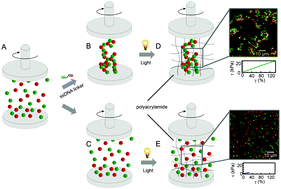The mechanical properties of polymer–colloid hybrid hydrogels†
Abstract
The incorporation of monodisperse colloidal particles in hydrogels is a promising approach to create hybrid gels with unique structural, mechanical and functional properties. However, the colloidal structure formation within the hydrogels often remains uncontrolled, leaving behind possible mechanically synergetic effects of the polymeric and the colloidal system. Here we show that colloidal structure formation within the hybrid gels has a significant influence on the elasticity and toughness of the hybrid gels. We combine a polyacrylamide hydrogel with DNA coated colloids (DNAcc), where structure formation can be triggered independently at different points in time. Consequently, we are able to create hybrid gels that are composed of the same components, but do differ in explicit colloidal structure. While monodisperse colloids enhance the storage modulus of the gels, the yield strain is simultaneously drastically reduced. The toughness of these brittle hybrid gels is rescued by colloidal structure formation at higher polyacrylamide concentrations. The toughness is increased at lower polyacrylamide concentrations. We show that the toughness of the hydrogels at 10% (w/v) polyacrylamide and 4% (v/v) DNAcc can be increased by a factor of approx. 35, indicating that control over colloidal structure formation yields access to significant synergetic effects in polymer–colloid hybrid gels.


 Please wait while we load your content...
Please wait while we load your content...